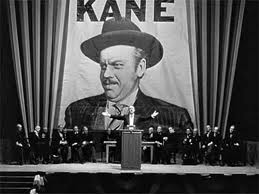The history of film can be told in lists. At least, that is what you’d be forgiven for thinking if you were a regular buyer of popular film magazines or were to wander the aisles of any book store’s collection of tomes on film. The American Film Institute has an entire section dedicated to lists on their website, following their 100 Years…100 Movies series. If lists ever had significance, much of this has been diminished by the promotional nature of the device, largely used to sell magazines or promote campaigns. Regular readers of popular film magazines may have seen The 500 Greatest Films of All Time on several passes now, or wonder if there are any genres left to tackle. Indeed, every month Empire lists a new Top 10 of something, with the most recent Australian edition barrel-scraping by listing the Top 10 Most Superficial Characters. We too are guilty of this, devoting a section of The Reel Bits’ articles to Lists as well. Perhaps a Top Ten Lists of All Time is in order?
A steady canon
The idea of a film canon, a set of films by which all other films should be benchmarked, is the underlying ideology behind the plethora of lists that emerge from various film societies, critics and publishing houses. Attacked as elitist by some, writers/filmmakers such as Paul Schrader (perhaps best known for his Taxi Driver script) defends the need for a canon in his musing on the state of film writing in 2006 article for Film Comment entitled Canon Fodder. Excluding documentaries, non-narrative films and repeat entries from the same director, Schrader lists 20 films in his canon, with an additional forty runners-up. His idea was to “counter the proliferation of popularity-driven lists”. This argument, however, tends to be based on film as a singular kind of medium. So how important is a film canon in 2011, when the world of film is constantly evolving with new production and delivery methods, with major directors shooting films on iPhones or delivering them via online platforms such as MUBI?
This debate is nothing new. Back in 2002, Dan Sallitt wrote (on Slate) about the prestigious Sight & Sound list, The Greatest Ten Films of All Time, that appears once a decade. Sallitt argued that while the list purports to be “a snapshot of the evolving film canon” that even with “a few shifts and substitutions” very little had changed in the ten years since the last poll. Indeed, Citizen Kane had been the top film in 1962, and remained that way forty years later. “Unfortunately”, he added “for the foreseeable future…major directors of today’s cinema are likely to appear in the Sight & Sound polls only as commentators”.
Indeed, this is true of so many lists. On the AFI’s 2007 edition of 100 Years…100 Movies, the two most recent films in the Top 10 were from 1972 (The Godfather) and 1980 (Raging Bull). All other film in the Top 10 had been released prior to 1965. Of the 23 “new” films added to the list, only two had been released since the creation of the previous list in 1997. One of the new entries, coming in like a rocket at #18, was 1927’s The General, a cracker of a film to be sure: but did it really need a 2007 list to remind us of that? Surely there had been some seminal pieces of cinema in the previous decade that demanded more widespread attention? Is it not the duty of organisations such as the AFI to promote all cinema to the world, especially those that don’t make the mainstream, rather than dust off the same Citizen Kane-centric lists once a decade?
New ammunition
Yet currency doesn’t seem to be the only solution either, with recent editions of 1001 Movies You Must See Before You Die controversially dropping classics in favour of the occasional flash-in-the-pan hit. The latest edition has added Todd Phillip’s The Hangover and James Cameron’s Avatar, yet dropped Jean-Pierre Jeunet’s Amelie. Why? Film is a constantly evolving medium, in a state of flux because it is one of the newest in the overall history of art. Yet to use Schrader again, his definition of a canon is that a film must be “by definition, based on criteria that transcend taste, personal and popular”. (For the record, his own Taxi Driver comes in at 36). Some of the more recent entries on the 1001 Movies You Must See Before You Die list certainly fail on that last count. If a film does not stand the test of time, as some would argue is the case with Citizen Kane, Gone with the Wind or more recently The Return of the King or Avatar, should it be stricken from the record? Is it no longer “good film”, or is it simply a case of pandering to changes in taste? Both are perfectly valid responses, and there is no reason they need to be mutually exclusive.
So lists are full of problems, and often represent the subjective interests of a handful of (possibly) elitist critics? Yes, and no. As mentioned, Schrader’s own list contains a film he penned, but does this mean it is not objectively an ‘essential’ film? Of course not, and countless other critics will testify to the power of Martin Scorsese’s urban nightmare, while others may dismiss it as mindless violence. The point is that film criticism is necessarily a subjective pursuit, often as much about crafting one’s own clever language around someone else’s work. Yet it is through this critical engagement that a deeper appreciation of film is achieved, with personal canons created almost every day. The act of watching is reviewing: it is comparing with what has come before and what will potentially come. To restrict the canon to an agreed upon set of films – to set the bar too highly as it were – even if those films have been selected by a society (or group of societies), is to narrow the view too much. In this light, a canon restricts the effervescent imaginations of critics around the world, but it is the same ‘old school’ thinking that causes filmmakers to rebel and create something entirely new every generation or so.
You may fire when ready
No matter what it is called – a film canon, a ‘best of’ list or the ‘Top Films of All Time’ – they all serve a similar function as a starting point. To think of them as the base by which other films are measured has its uses, but with hundreds of worthy titles released around the world every decade, it is far too limiting to tie ourselves to old-guard notions of what constitutes good film. Rather, we (both critics and audiences alike) should use each and every list as a place to discover new and exciting films from around the world, in the hope that we will one day have a personal list of films that defines each of us and our personal journey through cinema.






